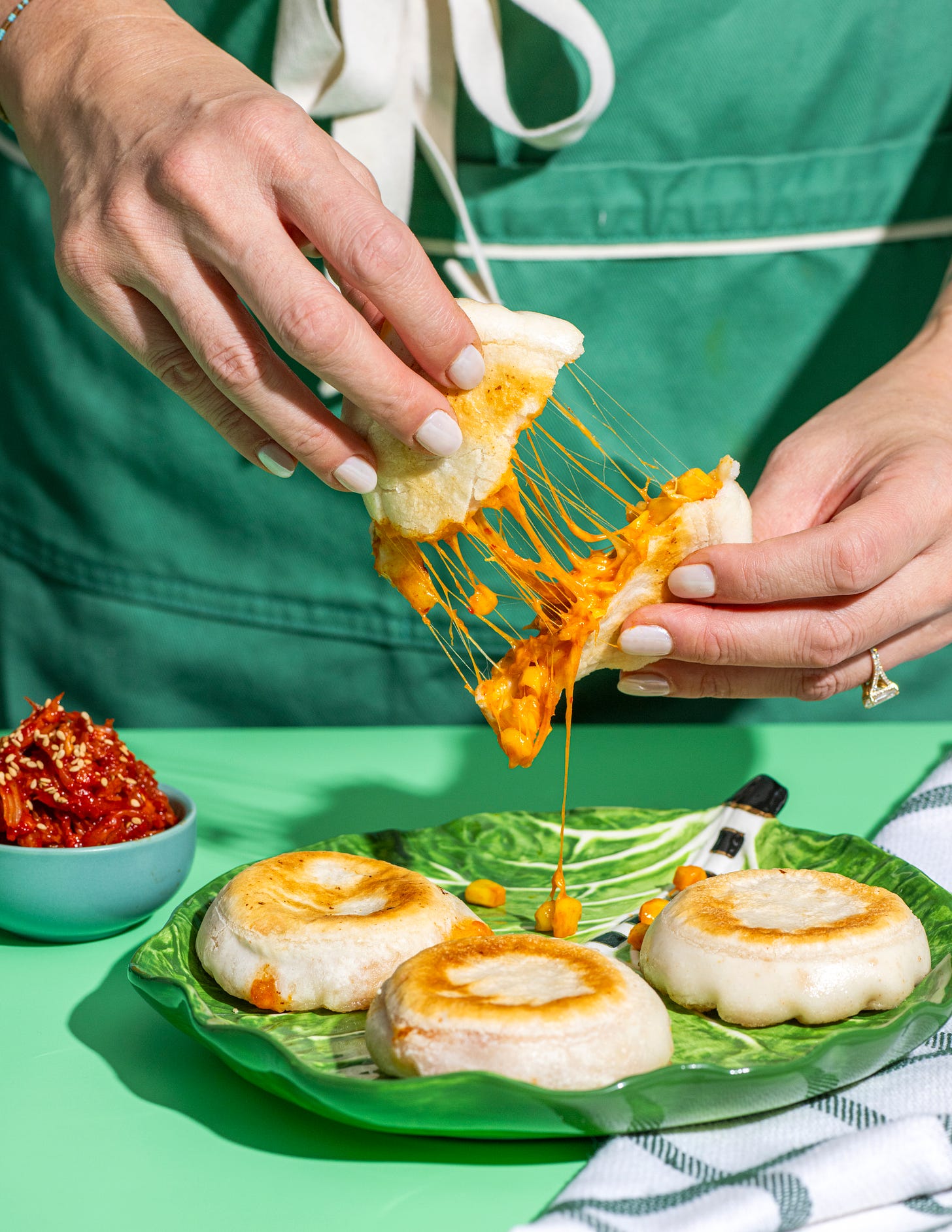Clarice Lam and I have been following one another on social media for a while, but had yet to link up IRL…until the James Beard Awards in Chicago this past June.
We ran into one another at the after party and were like, “OMG HEY!!!!”
It’s always so funny meeting someone that you know online in real life.
I knew she had a cookbook coming out so was like, “LET’S DO SOMETHING ASAP.”
And thus, this little video collab came to be.
Clarice’s book, “Breaking Bao: 88 Bakes and Snacks from Asia and Beyond” is full of fun recipes that you’re going to want to try. Gochujang Pizza Rolls, Vietnamese Coffee Viennetta (I LOVE Viennetta), and Wild Mushroom-Boursin Lo Pau Bang…I mean, come on.
We decided to make the Kimchi and Corn Cheese Pan-Fried Mochi because, well, I love kimchi. And cheese. And corn.
a lot of kimchi content this month, huh?
I like what I like, what can I say.
Needless to say, we had a blast cooking together.
The recipe is easy, but we miiiight have messed it up a tad little bit. BUT WE GOT THERE IN THE END.
Basically, we were chatting so much about our mutual love of corn that the water we were boiling for the recipe evaporated a little too much, so the dough was a tiny bit dry. The fix? Use wet hands to roll the dough into balls before rolling it out into discs before filling it with kimchi, cheese, and corn.
Also, snacking corn.
Clarice is incredible and her book is so fun and don’t forget to BUY IT and find her on tour this fall!
ty ily byeeeeeee.
Kimchi & Corn Cheese Pan-Fried Mochi Recipe
The inspiration behind this dish comes from two of my favorite Korean dishes: corn cheese and tteokbokki, spicy stir-fried rice cakes. Korean corn cheese technically falls into the category of anju, dishes that are served with alcohol, but is also frequently served as a side dish at Korean BBQ restaurants. I usually finish it before the meat even hits the table. It’s made of corn, mayo, and seasonings, topped with a mountain ofshredded cheese, and cooked under the broiler until brûléed and gooey. It’s the perfect comfort food. When I make tteokbokki at home I like to add cheese to cut through the spiciness, and when I make corn cheese at home, I like to add kimchi. So why not combine all three iconic Korean foods into one dish?
Makes seven 1¾ ounce|50 gram pieces
for the pan-fried mochi dough:
2 cups|220 grams Mochiko or glutinous rice flour
2 teaspoons granulated sugar
¼ teaspoon kosher salt
2 teaspoons vegetable oil
for the kimchi-corn cheese filling:
1 tablespoon Kewpie or regular mayo
½ tablespoon unsalted butter, melted
2 teaspoons gochujang
1 teaspoon granulated sugar
1 ⅓ cup|200 grams fresh, frozen, or canned and drained corn
½ cup|50 grams shredded low-moisture mozzarella
2 tablespoons roughly chopped kimchi
2 garlic cloves, minced
2 to 4 tablespoons vegetable oil
2 scallions, finely sliced, for garnish (optional)
To make the mochi dough, in a medium mixing bowl, add the Mochiko. In a small pot, bring ½ cup + 1 tablespoon of water, the sugar, and the salt to a rolling boil.
As soon as it boils, remove the pot from the heat and pour it into the bowl with the Mochiko. Using a pair of chopsticks or a fork, stir the dough until it won’t stir anymore. It should look like a shaggy lump of dough. Cover the bowl tightly in plastic wrap and allow to sit for 5 minutes.
Remove the plastic wrap and add the vegetable oil. Knead the dough by hand in the bowl until the oil is incorporated, then transfer it onto your work surface and knead until smooth, about 5 minutes. Roll it into a log and wrap in plastic wrap. Allow the dough to rest for 30 minutes.
Meanwhile, make the kimchi–corn cheese filling. In a small mixing bowl, whisk together the Kewpie, butter, gochujang, and sugar until combined.
Add the corn, mozzarella, kimchi, and garlic and mix well. Set aside.
Divide the dough into seven equal (50 gram) pieces. Lightly grease your work surface with some vegetable oil. Roll a portion into a ball and flatten it into a 3½ inch|9 cm disc using the palm of your hand. Keep the rest covered in plastic wrap so it doesn’t dry out.
Place about 3 tablespoons of filling into the center of a dough circle. Gather all the edges together and pinch to seal into a ball shape. Make sure everything is completely sealed so it doesn’t ooze out when you fry them. Flip the ball over so the seam side is down and lightly flatten the ball into a hockey puck shape using the palm of your hand. Repeat with the rest. Keep the mochi covered with plastic wrap while you are shaping so the dough doesn’t dry out.
Preheat a large pan over medium heat. Add 2 tablespoons of oil and place the mochi bao in the pan, in batches if necessary, making sure to keep space between them so they don’t stick together. Cover the pan and fry until golden brown, 3 to 4 minutes on each side. (If you don’t cover the pan, they won’t cook all the way through before burning.) Add more oil if necessary. If they are turning brown too fast, lower the heat a little.
Place the mochi bao on a plate and garnish with sliced scallions, if desired. Allow to cool slightly before serving. The inside will be very hot.
Pro Tips & Storage
•I recommend eating these the day they are fried, but if you have leftovers, you can store them in an airtight container for up to 3 days in the refrigerator.
•They can be assembled in advance and stored uncooked in a single layer on a parchment-lined baking sheet or plate, wrapped in plastic wrap, for up to 3 days in the refrigerator or 3 months in the freezer. Cooking times will be longer if you are frying them straight from the fridge or freezer.
• Not a fan of spicy? Leave out the kimchi and gochujang; it will still taste great.
•Try substituting this filling for Chinese Bacon, Egg & Chive Filling (page 57), Wild Mushroom– Boursin Filling (page 65), Black Sesame Filling (page 82), or Chestnut Filling (page 87).
•You could also go more traditional and fill the mochi bao with red bean paste.
Excerpted from Braking Bao: 88 Snacks and Bakes from Asia and Beyond by Clarice Lam, ©2024. Published by Chronicle Books. Photographs © Evan Sung.

















Share this post